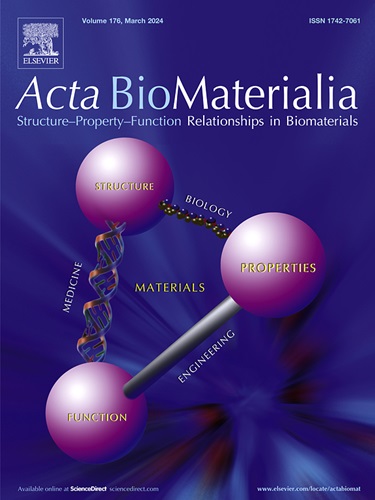Broad-spectrum downregulation of inflammatory cytokines by polydopamine nanoparticles to protect the injured spinal cord
IF 9.4
1区 医学
Q1 ENGINEERING, BIOMEDICAL
引用次数: 0
Abstract
Acute neuroinflammation, which is notably characterized by a significant elevation in pro-inflammatory cytokines and chemokines, often rapidly develops following a traumatic spinal cord injury and exacerbates damage in the lesion area. This study addresses the limitations inherent in strategies that regulate only a single or a few cytokines, which are often insufficient to counteract the progression of secondary injuries. We explore the use of polydopamine nanoparticles as a broad-spectrum immunomodulator, capable of capturing by adsorption a wide range of cytokines and thereby effectively suppressing neuroinflammation. Leveraging their adhesive properties, these nanoparticles promptly reduce levels of various excessive cytokines, including IL-1α, IL-1β, IL-6, IL-10, IL-17A, IL-18, TNF-α, MCP-1, GRO/KC, M-CSF, MIP-3α, and IFN-γ, primarily through physical adsorption. This reduction in cytokine levels contributes to the subsequent inhibition of pro-inflammatory M1 microglia and A1 astrocyte activation, aiding in the recovery of motor functions in vivo. In summary, polydopamine nanoparticles represent a versatile and effective approach for modulating acute neuroinflammation in spinal cord injuries. By broadly down-regulating cytokines, polydopamine nanoparticles propose an innovative approach for treating spinal cord injuries.
Statement of significance
The current study demonstrated the immunomodulatory potential of polydopamine nanoparticles in mitigating neuroinflammation following spinal cord injury. Both in vitro and in vivo analyses revealed significant downregulation of several key cytokines among a panel of 23 cytokines and chemokines. The potential underlying mechanisms governing these interactions were elucidated through comprehensive molecular dynamics simulations for the first time. Consequently, the downregulation of these cytokines and chemokines led to the inhibition of pro-inflammatory M1 microglia and A1 astrocyte activation in both in vitro and in vivo models. This inhibition protected neurons within the microenvironment, resulting in improved locomotor functions. Overall, this study underscores the prominent therapeutic efficacy of polydopamine nanoparticles in alleviating neuroinflammation, highlighting their potential as broad-spectrum regulators in intricate microenvironments.

聚多巴胺纳米颗粒广谱下调炎性细胞因子对脊髓损伤的保护作用
急性神经炎症的显著特点是促炎症细胞因子和趋化因子显著升高,通常在脊髓创伤后迅速发展,并加剧病变区域的损伤。本研究探讨了仅对单一或少数几种细胞因子进行调控的策略所固有的局限性,这些策略往往不足以对抗继发性损伤的发展。我们探索使用多巴胺纳米粒子作为一种广谱免疫调节剂,它能够通过吸附作用捕捉多种细胞因子,从而有效抑制神经炎症。这些纳米颗粒利用其粘附特性,主要通过物理吸附作用,迅速降低各种过量细胞因子的水平,包括 IL-1α、IL-1β、IL-6、IL-10、IL-17A、IL-18、TNF-α、MCP-1、GRO/KC、M-CSF、MIP-3α 和 IFN-γ。细胞因子水平的降低有助于随后抑制促炎性 M1 小胶质细胞和 A1 星形胶质细胞的活化,从而有助于体内运动功能的恢复。总之,多巴胺纳米粒子是调节脊髓损伤急性神经炎症的一种多用途有效方法。通过广泛下调细胞因子,多巴胺纳米颗粒为治疗脊髓损伤提供了一种创新方法。意义说明:本研究证明了多多巴胺纳米颗粒在减轻脊髓损伤后神经炎症方面的免疫调节潜力。体外和体内分析表明,在 23 种细胞因子和趋化因子中,有几种关键细胞因子被显著下调。通过全面的分子动力学模拟,首次阐明了这些相互作用的潜在内在机制。因此,在体外和体内模型中,下调这些细胞因子和趋化因子可抑制促炎性 M1 小胶质细胞和 A1 星形胶质细胞的活化。这种抑制作用保护了微环境中的神经元,从而改善了运动功能。总之,这项研究强调了多巴胺纳米粒子在缓解神经炎症方面的显著疗效,凸显了它们在错综复杂的微环境中作为广谱调节剂的潜力。
本文章由计算机程序翻译,如有差异,请以英文原文为准。
求助全文
约1分钟内获得全文
求助全文
来源期刊

Acta Biomaterialia
工程技术-材料科学:生物材料
CiteScore
16.80
自引率
3.10%
发文量
776
审稿时长
30 days
期刊介绍:
Acta Biomaterialia is a monthly peer-reviewed scientific journal published by Elsevier. The journal was established in January 2005. The editor-in-chief is W.R. Wagner (University of Pittsburgh). The journal covers research in biomaterials science, including the interrelationship of biomaterial structure and function from macroscale to nanoscale. Topical coverage includes biomedical and biocompatible materials.
 求助内容:
求助内容: 应助结果提醒方式:
应助结果提醒方式:


